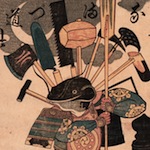|
JaucheCharly posted:There's a traditional dish here called "Fledermaus" ( = bat), which is a cow's sphincter. I've never eaten that and never will.
|
|
|
|

|
| # ? May 14, 2024 16:00 |
|
On the plus side a chariot can be blinged out to impress peasants who don't know it's worthless militarily.
|
|
|
|
"worthless" seems like a bit of a stretch - i mean, the dudes you'd be fighting wouldn't exactly be expecting it and just breaking the other guys' formations might be worth it in ancient warfare, surely
|
|
|
|
It just depends on the time period. There was a time when chariots had a role. By the standard thread time of classical antiquity cavalry had come into its own and they were a relic.
|
|
|
|
From what I've read about Indian Warfare in the ancient world they used the chariot for a long time after they developed decent cavalry, but as far as I can tell the main reason for using chariots at this point was because the kings and princes thought they were cool and maybe sort of noble tradition. Cavalry were still employed at the same time because the chariot arm of the army was small and chariots tend to get caught in battlefield disasters that disable them. I don't think they ever employed scything chariots on any scale, but there were even bigger chariots for up to six people (including drivers) to ride in pulled by four horses.
|
|
|
|
V. Illych L. posted:"worthless" seems like a bit of a stretch - i mean, the dudes you'd be fighting wouldn't exactly be expecting it and just breaking the other guys' formations might be worth it in ancient warfare, surely Especially worthless against rebelling peasants was my meaning, I guess it didn't come out that way.
|
|
|
|
HEY GAL posted:never eaten cow sphincter, but i can tell you right now that chinese pig intestines with hot chili are loving delicious Really I think it's a function of how "close" you are to your meat source. I grew up on a cattle ranch, but we didn't slaughter them ourselves and didn't use most of the offal. Heart, tongue, liver, sometimes testicles during branding but we stopped doing scalpel castration like a decade ago so not recently. Most of that stuff ends up in sausages so if you're in a sausage-loving part of Europe you're getting lots of non-muscle meat whether you know it or not. We did a lot of bird hunting and always kept all the giblets, that was considered a delicacy. If you hunted or raised an animal and then butchered it yourself it's really hard to throw anything useful out. As you get to more industrialized and urban society where you're buying cuts of meat from a store you're so removed from the animal source people don't even really think about what goes into livestock production. One of my favorite quotes about ecology and food is from Aldo Leopold's A Sand County Almanac (slight paraphrasing): quote:There is a grave spiritual danger in not owning a farm. One may come to believe that meat comes from a grocer, and heat from the furnace.
|
|
|
|
Jerusalem posted:No human life is worth losing over artifacts, but I'm pretty sure the guy knew they were probably gonna kill him anyway, and you've got to give props to a guy who had the balls to refuse to allow such historically significant things to fall into the hands of these giant dipshits. I sure as hell wouldn't have those kind of guts. I fear this is exactly what has happened, since I remember another recent case like this where the archaeologist in question got asked if he could help find some ill-defined magical treasures and was smart enough to run away as fast as he could. Because he knew there wasn't any treasure behind the old wall writings he was asked to decipher and he also knew what would start happening if he tried telling ISIS-goons they were retards. I'm thinking like in this other case, the treasure ISIS was searching for didn't exist. And they killed him because they're retards.
|
|
|
|
Re: Chariot Chat. Yeah, they were ineffective compared to normal cavalry. No, they wouldn't stop because of resistance from legs/bones/etc. They would pummel right through. That doesn't make them good, as it was easy enough to get out of the way, but it was there to generally keep guys off of your rear end when continuing through infantry.
|
|
|
|
V. Illych L. posted:"worthless" seems like a bit of a stretch - i mean, the dudes you'd be fighting wouldn't exactly be expecting it and just breaking the other guys' formations might be worth it in ancient warfare, surely If you're fighting an organised military that has cavalry, they'll just send some guys out on horses to throw javelins at your chariots.
|
|
|
|
Ithle01 posted:as far as I can tell the main reason for using chariots at this point was because the kings and princes thought they were cool and maybe sort of noble tradition. Romans used chariots all the time. At the Hippodrome.
|
|
|
|
Xander77 posted:In other news. Apparently, in the medieval period the entrails / tongues / eyes / hearts / tongues were considered to be the best parts of an animal, and the muscle fiber was either discarded, or left to the servants. Was that the case in Roman/Greek times as well? What changed between then and now?
|
|
|
|
Offler posted:I don't know where I'm going with this, I'm just trying to think of reasons that a weapon that sound so fearful wasn't used more. Maybe it's an example of something that sounds good in theory but is extremely difficult to make work in practice. As others have said, this is pretty much it. A scythed chariot is terrifying, but kind of a gimmicky weapon. It's expensive, difficult to maneuver, and once your opponent figures out how to deal with them they're basically useless. Kind of like war elephants (at least in the Mediterranean). They look cool and scary, but they're expensive and not really good at anything, and often times they're more dangerous to your own troops.
|
|
|
|
I've often wondered as well; a man on a horse can traverse pretty much any terrain that a horse can walk over, making him extremely mobile. On any reasonably even ground, he can move pretty rapidly. This is the obvious advantage of cavalry. A chariot, by comparison, can move as fast as the cavalry (maybe a touch slower due to weight,) but is going to be absolutely screwed by any kind of mud, soft ground, or rocks, even more than a cavalryman. So, were ancient chariot battles fought on agreed-upon ground, or were most battles just an infantry affair, surrounded by a generous smattering of chariots with broken wheels and axles? It would seem that the best way to defeat chariot cavalry would be to simply retreat to the nearest patch of lovely terrain.
|
|
|
|
MrYenko posted:So, were ancient chariot battles fought on agreed-upon ground, or were most battles just an infantry affair, surrounded by a generous smattering of chariots with broken wheels and axles? It would seem that the best way to defeat chariot cavalry would be to simply retreat to the nearest patch of lovely terrain. In other news, a page or so back, posters kinda posit that armies would clear out battle grounds to make them suitable for chariot combat. ... As to myself, I don't really get the "all the enemy have to do is part to let the chariots pass". Isn't breaking up your enemies formation a huge tactical advantage?
|
|
|
|
Xander77 posted:
It would be if the attacks between the different arms were coordinated, but on many occasions that's often not the case and a disciplined enemy can recover their formation before a rout or cavalry stop skirmishing and exploit the opening. I think the idea is that a less disciplined armies might just loose coherence and fall apart which is why when chariots go against Roman legions at Magnesia or Alexander's armies they fail so miserably. Once again, going back to what brief bits I've read of Indian warfare chariots appear in the epics as a car for delivering your Epic Hero to battle against another Epic Hero while the masses of Nobodies run around chaotically in the background.
|
|
|
|
Xander77 posted:As to myself, I don't really get the "all the enemy have to do is part to let the chariots pass". Isn't breaking up your enemies formation a huge tactical advantage? It depends on how disciplined the enemy is and how quickly they can regroup, but usually the answer is yes, it is a pretty big advantage.
|
|
|
|
Pellisworth posted:Really I think it's a function of how "close" you are to your meat source. I grew up on a cattle ranch, but we didn't slaughter them ourselves and didn't use most of the offal. Heart, tongue, liver, sometimes testicles during branding but we stopped doing scalpel castration like a decade ago so not recently. Most of that stuff ends up in sausages so if you're in a sausage-loving part of Europe you're getting lots of non-muscle meat whether you know it or not. There's a guy in Bulgaria that makes the bone reinforcements on these composite bows out of cow ribs   It's fantastic to see how much in these bows actually comes from an animal, lots of collagen glue, sinew, horn and bone, barely any wood.     This is also close to what a late roman composite bow might have looked like. A fragment of such a bow with wood still left (highly unusual) from the roman period was found in Oxyrhynchus (Egypt). It's currently in the Pitt-Rivers Museum in Oxford. Dunno if it's on display, but probably.   This site was dug up in 1897 and yielded mostly papyri, sadly not much else is know about the bow fragment. It bears some resemblance to finds of Turko-Khazar bone plates, but these are significantly longer and also show some scoring on the back, where an additional layer of sinew was.   While there were no boneplates of Sassanian bows found, the find in Egypt shows closer resemblance to this type of design that is known from carvings linked to Khosrau II.
|
|
|
|
MrYenko posted:I've often wondered as well; a man on a horse can traverse pretty much any terrain that a horse can walk over, making him extremely mobile. On any reasonably even ground, he can move pretty rapidly. This is the obvious advantage of cavalry. Afaik, most pre-industrial battles were fought on agreed-upon ground, chariots or not.
|
|
|
|
JaucheCharly posted:Bows Iirc, you said that Greek bows' draw weight was restricted by the horns they had available. Would the rib bows have been better?
|
|
|
|
MrYenko posted:So, were ancient chariot battles fought on agreed-upon ground, or were most battles just an infantry affair, surrounded by a generous smattering of chariots with broken wheels and axles? It would seem that the best way to defeat chariot cavalry would be to simply retreat to the nearest patch of lovely terrain. Yep. All cavalry armies tried to force battle on open, flat terrain, and the most common method of dealing with them by competent commanders was to not allow that. Cavalry are better at negotiating terrain than chariots, but infantry is better at it than a horse. If you had the option then withdrawing into rough terrain was always a good idea if the enemy relied on cavalry. Of course, things are never that simple. Let's say you have some convenient craggy hills with decent tree cover. If you withdraw your infantry army into that, the enemy's cavalry is going to have a lot of trouble attacking you. However, now your army is stuck in the hills and the cavalry can go burn all your farms and villages in the nice, flat terrain part of your country. Congrats, you've kept your army safe but rendered it useless in defending your country, which is the point of all this isn't it? Korean history is excellent if you want to read about effective retreating. Conquerors were never able to hold Korea because everyone would scatter into mountain fortresses that were a loving nightmare to assault and mount guerrilla raids.
|
|
|
|
Regarding earlier chariotchat: if I remember right, scythed chariots were adopted by a few of the successor states after Alexander's conquest. Exactly how they were used and constructed is a bit of a mystery, though. The problem is that the Hellenistic period is poorly documented. Horribly documented, really, especially compared to what's right before and after it in the same part of the world. And it's my favorite ancient era 
|
|
|
MrYenko posted:I've often wondered as well; a man on a horse can traverse pretty much any terrain that a horse can walk over, making him extremely mobile. On any reasonably even ground, he can move pretty rapidly. This is the obvious advantage of cavalry. If you are fighting as a phalanx or in a similar formation then it's also in your interest as infantry to be on level ground. Inclines and obstacles gently caress up your cohesion. One of the most revolutionary aspects of the maniple system was its increased capability to handle rough terrain - the hill-people Samnites clowned the Romans constantly before Rome adopted it from them.
|
|
|
|
|
Hogge Wild posted:Iirc, you said that Greek bows' draw weight was restricted by the horns they had available. Would the rib bows have been better? Bone/antler reinforcements in the tips and grips were necessary, as the way of construction changed. They didn't use bone in the bending sections, because it is brittle and stiff, that would have been some sort of horn, but we don't know if it was ram or buffalo.. Instead of the super complicated design of scythian bows, that sported +9 wooden parts and had the ibex horn sandwiched along the centerline, the new one had 3-4 wooden pieces with the horn on the belly and were larger. But the parts weren't spliced yet, but glued on by overlapping, like this, which made plates and sinew wrapping necessary, so that they don't fall apart.  Somewhere around the 7th or 8th century turkic people in Mongolia or Khazakstan started to splice grips and ears and the plates became obsolete. Afaik, the findings in the grave of Zargalant are the earliest of the new mode of construction. The plates are an absolute nuisance to make anyway. Antler is superior to bone, but finding the right pieces takes a long time, unless you sit on a mountain of antler.
|
|
|
|
Jazerus posted:the hill-people Samnites clowned the Romans constantly before Rome adopted it from them. Point of curiosity here - I've often heard it said that one of Rome's great strengths (early on, at least) was its ability to adapt and learn from its enemies, picking up whatever worked even if it was different and foreign. Was this an active point of pride for the Romans? Like, did they view it as a national strength, the fact that unlike all the other idiots they fought they were willing to try new things? Or was it more a retroactive "What are you talking about, we've always used maniples, don't be silly"?
|
|
|
|
They were pretty open about it. They said right in the name that the gladius was from Hispania and never pretended they didn't learn to make lorica hamata from Gauls. I don't think the Romans felt any shame about seeing something that worked and adopting it. They were a very pragmatic bunch. Consider the national myth is that Romans were the dispossessed and outcast of the world come together as a people. Anyone could become Roman. The Roman religion readily adopted foreign gods. There's always this thing (until late antiquity when they become dicks) about Rome as an amalgamation of peoples and things from elsewhere.
|
|
|
|
Chariots totally dominated warfare for over a thousand years. They appear in the oldest literary traditions of every culture between Ireland and China, and maintained niche tactical use for hundreds of years after the emergence of true cavalry. In their heyday they were used in the wet forests of Western Europe, the rocky hill country of the Balkan Peninsula, and the entire sweep of the Asian deserts and steppe. They were not a "gimmick," even if by the time of Gaugamela their usefulness had declined.
|
|
|
|
I said scythed chariots were a gimmick weapon, not all chariots.
|
|
|
|
Squalid posted:Chariots totally dominated warfare for over a thousand years. They appear in the oldest literary traditions of every culture between Ireland and China, and maintained niche tactical use for hundreds of years after the emergence of true cavalry. In their heyday they were used in the wet forests of Western Europe, the rocky hill country of the Balkan Peninsula, and the entire sweep of the Asian deserts and steppe. They were not a "gimmick," even if by the time of Gaugamela their usefulness had declined. So why were they so great, or is that they were the only cavalry available when horses were too small to carry an armed man at a useful speed?
|
|
|
|
The reasons were the small horses and the chariots being a stabler platform for archery than horses without stirruped saddles.
|
|
|
|
I'm not sitting in front of a source here but scythed chariots are a combined arms weapon, they're supposed to smash through a formation and be immediately followed up by cavalry or light infantry, which would presumably allow the chariot to escape. Except at Chaeronea Sulla didn't even let the Pontics have the room to make use of the chariots.
|
|
|
|
ISIS blew up a temple at Palmyra. I know we were talking about it a while ago. Figured I'd share the solemn news to all of you.
|
|
|
|
Hamlet442 posted:ISIS blew up a temple at Palmyra. I know we were talking about it a while ago. Figured I'd share the solemn news to all of you. I think that it's pretty clear that they're going to demolish the site before they leave, as they generally do with any historical artifacts that they can't sell. The only reason they haven't yet is that they've been torturing the Palmyra curator for more things to loot, as well as the fact that the US is refraining from bombing their camp because of the historical artifacts. Now that the curator has been executed, I'd expect the site to be destroyed for propaganda purposes. Of course news has been fairly slow to get out of the area (these events apparently happened several months ago) so who knows what kind of damage Palmyra has suffered since then. Kaal fucked around with this message at 17:21 on Aug 24, 2015 |
|
|
|
Arglebargle III posted:So why were they so great, or is that they were the only cavalry available when horses were too small to carry an armed man at a useful speed? I dunno! Probably it depended on the time and place, they were flexible platform. In their prime, many of the forces facing chariots would have been civic militias or tribal levies, so the moral effect shouldn't be discounted. From Caeasar's commentaries: quote:Their mode of fighting with their chariots is this: firstly, they drive about in all directions and throw their weapons and generally break the ranks of the enemy with the very dread of their horses and the noise of their wheels; and when they have worked themselves in between the troops of horse, leap from their chariots and engage on foot. The charioteers in the meantime withdraw some little distance from the battle, and so place themselves with the chariots that, if their masters are overpowered by the number of the enemy, they may have a ready retreat to their own troops. Thus they display in battle the speed of horse, [together with] the firmness of infantry; and by daily practice and exercise attain to such expertness that they are accustomed, even on a declining and steep place, to check their horses at full speed, and manage and turn them in an instant and run along the pole, and stand on the yoke, and thence betake themselves with the greatest celerity to their chariots again The Persian scythed chariots may not have stopped Alexander's conquest, but considering the Greeks immediately adopted them and continued building them for hundreds of years, they probably saw some value in the things. Strange considering how badly they performed in all the battles I've read about, although perhaps they really shined in other kinds of encounters. Much of classical warfare consisted of skirmish and foraging, when soldiers left the large formations which in pitch battles protected them from chariots. From Xenophon's Hellenica: quote:The soldiers had got into the habit of collecting their supplies carelessly and without taking precautions. There was one occasion when Pharnabazus, with 2 scythed chariots and about 400 cavalry, came on them when they were scattered all over the plain. When the Greeks saw him bearing down on them, they ran to join up with each other, about 700 altogether; but Pharnabazus did not waste time. Putting the chariots in front, and following behind them himself with the cavalry, he ordered a charge. The chariots dashing into the Greek ranks, broke up their close formation, and the cavalry soon cut down about a hundred men. The rest fled and took refuge with Agesilaus, who happened to be close at hand with the hoplites.
|
|
|
|
the actual use of the chariot is for firing arrows, not crashing into the enemy. In the Iliad chariots are used purely as transport, but Homer was around hundreds of years after the chariots zenith in the mediterranean.
|
|
|
|
JaucheCharly posted:There's a guy in Bulgaria that makes the bone reinforcements on these composite bows out of cow ribs You're way cool and I don't mind you don't eating cow's rear end.
|
|
|
|
Future people reading this thread posted:Wait, so he'll eat his girlfriend's rear end but not a cow's? Man these 21st century guys were weird Keldoclock fucked around with this message at 17:11 on Aug 27, 2015 |
|
|
|
People and farm animals put their dicks in all kinds of orifices, as your mom can surely testify.
|
|
|
|
What kind of food did sailors eat? Obviously if you're just going around the Med you can go ashore whenever, but on longer voyages did they eat cold food for months at a time? Or if they cooked, where did they get the firewood?
|
|
|
|

|
| # ? May 14, 2024 16:00 |
|
Ancient ships foraged a lot since they didn't go far from shore. Whenever possible ships would stop ashore every night. At sea they ate the same kinds of rations sailors have for ages, and a lot of land travelers for that matter. Hardtack-like breads, salted meat, fish, hard cheeses.
|
|
|

































